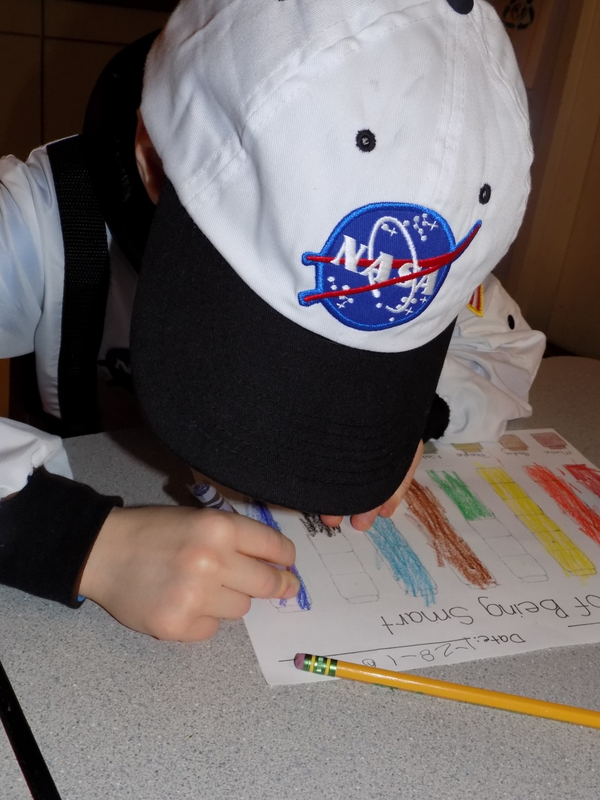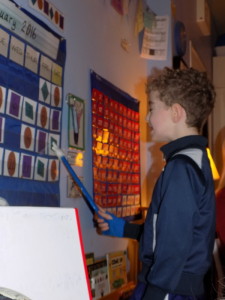Each classroom at Gardner is named using the Native names for a mountain or mountain range in the Cascades. D’s Kindergarten “Kalama” classroom refers to “the eruptive period of Mt. St. Helens.” Here is a description from the school’s web site:
Mt. St. Helens is a young mountain. It is also one of the most active volcanoes in the Cascades. The volcano has been extensively studied and its eruptive history is known with great clarity. Scientists divide the history of Mt. St. Helens into four periods. The Kalama eruptive period began in the winter or early spring of 1479-1480. Many Native American legends describe vividly the volcanic activity of the Kalama period.
And how true it is! What a spot-on way to describe this rich time in D’s life.
I felt that Katherine’s latest dispatch really illustrates this activity:
Dear Families,
As our class learns about homes from around the world, we ask two questions (from the perspective of the people we are learning about,) Where are we? and Who are we? Usually the outside of the home reflects the resources found in a particular region used as building materials. What is found on the inside of the home frequently reflects a person’s culture, values, and beliefs. We are also investigating the questions, “What makes a home?” and “Why are homes important?”
Last week we took a look at homes of Inuit people in the Arctic Circle. Igloos were traditionally used as hunting shelters during the winter. We noticed that winter homes were made of ice/snow and summer homes were made of skin tents. That has changed now. Tents are presently made of a variety of human-made materials, as are clothes. Some traditional fur and skin clothing is worn, but many people regularly wear store bought clothing. In class, the kids worked on making their own clay igloos on Thursday. Then on Friday, we took an imaginary trip to Northern Alaska. We sang a song about a seal hunt and then each person was given a paper with a wide variety of clothing and accessories. They each had a paper suitcase and were allowed to bring only 5 items. Each person studied the sheet of clothing and accessories and cut out five images to place in the suitcase. Then they shared what they had chosen with a friend. Finally, as a whole group we talked a little bit about items the kids thought would be very helpful in the cold.
Here is a song we sang while counting with one-to-to one correspondence during math:
“One little, two little, three little caribou,
four little, five little, six little caribou,
seven little, eight little, nine little caribou,
ten caribou on the tundra.
Ten little, nine little, eight little caribou,
seven little, six little, five little caribou,
four little, three little, two little caribou,
one caribou on the tundra.”
This week we will be talking about earthen homes found in a variety of places. We will learn about making cob, adobe, and mud homes and where each type of home is often found. From Morocco to England, South Africa to Oregon, there are earthen homes all across the world. We will make model earthen homes at the end of the week.
Multiple Intelligences Revisited
Last Thursday, we revisited the idea of different ways of being smart. Each person was given a graph of the Multiple Intelligences just like the one filled out in September and asked to fill it in now, based on what s/he learned about himself/herself over the past five months. Each “smart” was color-coded and rated on a scale from 1 to 6. The activity provided an opportunity to remind the group that everyone has his/her own gifts and challenges. Doing your best will look different than anyone else doing his/her best, and that is okay.
100’s Day
On February 11 we will be celebrating our 100th day of Kindergarten. We have been keeping track of the days that we have been at school since the first day and recently a countdown to the 100th day began. We will celebrate with a variety of activities that relate to the number 100.
Valentine’s Day
Valentine’s Day is coming soon. In Kalama we celebrate friendship for Valentine’s Day. Our celebration will take place on February 12. All Kalama students are invited to make cards to share with their peers. Making valentines tends to benefit both the sender and the receiver. If your child chooses to bring valentines for classmates, there need to be cards for everyone in the class. In the morning on the 12th, students sort valentines and place them into bags with peer names on them. Then at the party, students reach into their bags, pick one valentine and read from whom it came. The receiver walks to the giver and personally thanks him/her. The giver says, “You are welcome.” Then the process begins again until every valentine has been read and all friends have been thanked. After valentine bags have been put into cubbies, there will be friendship games and activities. If children receive candy with valentines, they will be asked to take it home and you can decide when they may have it. J If you would like to send in a snack, please let me know.
Here are the names of the people in our class:
Aiko
Dashiell
Elsie
Emma
Evan
Gabriel
Jamison
Julie
Kaleb
Kennedy
Lily
Samara
Sami
Stelios
Teachers: Katherine and Sarah
All Day Open Choice
February 17 will be our next all day Open Choice. Two of the classes will take place off campus and two will be on campus. If your child is taking part in either the visit to Downtown Portland/ Powell’s Books or Ice Skating in Vancouver, the leaders will contact you via email with more information. Open Choice classes allow students to try activities that differ from their regular school day and take place with a multi-age peer group. Please let me know if you have questions about this fabulous day.
Thank You
I want to give a special thank you to Christopher Maguire who came in to the Kalama classroom and played a steel guitar for the students during rest time last Thursday. It was such a treat!
Here are the photos of D that went with the email:



I think it is very interesting to see how D rated himself on the Multiple Intelligences graph. For instance giving himself a relatively low rank for his ability to be “self” smart was not what I would have predicted. I was also surprised to see the lower rank for “nature” as I think he is quite attuned to it. Maybe in his mind the intelligences translate to “interesting”?
It was also interesting to compare the rankings across the classroom (other kiddos not pictured here). Samara, who Dashiell expects to marry (in Hawaii), gave herself maximum high marks in each category. So D has already hitched himself to a strong confident young woman!
Leave a Reply